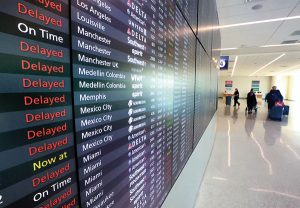Bloomberg
An overlooked software flaw is opening up US aviation authorities to new scrutiny over the resiliency of the systems that keep the nation’s planes moving.
Federal Aviation Administration (FAA) officials were still working to determine what went wrong in an outage that prompted a nationwide flight stoppage. The agency said preliminary findings traced the cause to a “damaged database file†— confirming an earlier Bloomberg News report — and there’s no
evidence of a cyberattack.
The system breakdown immediately attracted criticism from prominent lawmakers and aviation industry leaders, just weeks after Southwest Airlines Co. was called out by authorities for its own technology failures.
“The FAA’s inability to keep an important safety system up and running is completely unacceptable and just the latest example of dysfunction within the Department of Transportation,†Texas Senator Ted Cruz, the leading Republican on transportation issues, said in a statement.
The system outage heightens tensions after an already-contentious year in which airlines and Secretary of Transportation Pete Buttigieg traded accusations over who was most responsible for air-traffic disruptions. It also sets up a potential showdown as Congress prepares to write legislation setting FAA policy for the next few years. Senator Maria Cantwell, a Washington Democrat who chairs the Commerce, Science and Transportation Committee, said the committee will be “looking into†the FAA meltdown.
The situation is an awkward turn for aviation officials, coming shortly after the Southwest meltdown stranded thousands of passengers during the holidays.
“We have the secretary who lambasted Southwest and the airlines over their response to avoid cancellations and delays and provide compensation, but right now he doesn’t appear to accept responsibility or provide a clear answer when his own department fails,†said Kenneth Quinn, a partner at the Clyde & Co law firm and former chief counsel for the FAA. “Who’s going to compensate these affected passengers?â€
Buttigieg, speaking to reporters Wednesday at a conference in Washington, defended the FAA’s decision-making and said the agency would address the issue.
“We are a government system — we are going to own it, we’re going to find it and we’re going to fix it,†Buttigieg said. “My top priority right now, now that the system is working again as of about 9 this morning, is to understand the root cause, understand how it could have led to this level of disruption and understand how to make sure that it does not happen again.â€
The impacts were significant — there were 9,388 delayed US flights as of 6 pm in New York on January 11, according to tracker FlightAware — but still well below Southwest’s problems in recent weeks. The Dallas-based carrier cancelled 16,700 flights from December 21 through December 31 when a winter storm stranded planes at airports across the northern states, overwhelming the airline’s outmoded crew scheduling system.
The FAA’s crisis centered on the system producing Notice to Air Missions, known as Notams. Officials a little over a year ago expressed concern about the system’s reliability.
“There’s a fair amount of redundancy in the existing system today,†Jim Linney, the FAA’s director of operations support, said on an October 2021 webinar, according to a recording of the event. “It’s not where we want it to be for the future, which is why we’re investing in modernising that infrastructure.â€
The Oklahoma-based system has a backup at an FAA facility in New Jersey, Linney said.
The agency has been in the process of updating the Notam computer system and in recent years has made it easier to obtain the notices and to search them. But the underlying
system that failed is based on older technology.
The upgrade was behind schedule, at least in part as a result of cuts in funding to the agency’s technology budget, the people said.
While the FAA has had prior issues with technology, it has upgraded most of the US air-traffic system’s computers with more modern equipment and transitioned to satellite-based flight monitoring.
Federal data suggests FAA’s reliability has improved dramatically. Flight delays attributed to the FAA, which also include most weather-related issues, have fallen from about 60% in 2003 to 36% this year through October 2022, according to Transportation Department data. That occurred even as the FAA wrestled with staffing issues and Covid-19 disruptions.
The FAA Notam system provides critical safety information to pilots, such as runway conditions and issues with restricted airspace, and they are required to review them before each flight. FAA air-traffic controllers also must radio pilots updated Notams if they’ve changed after departure.
“Because the FAA runs conservatively — and the airlines the same thing — when this came up they stopped service,†said John Hansman, an aviation professor at the Massachusetts Institute of Technology. He said the system isn’t nearly as critical as flight-tracking technology or instrument landing systems.
The FAA said that flights in the air during the shutdown were able to land normally.
Still, the chaos gave the industry an opening to turn the spotlight back on the authorities that had been quick to criticise carriers’ operational records in recent months.
The “catastrophic system failure is a clear sign that America’s transportation network desperately needs significant upgrades,†said Geoff Freeman, chief executive officer of the US Travel Association, the lobbying group for the travel industry. “Our nation’s economy depends on a best-in-class air travel system.â€
 The Gulf Time Newspaper One of the finest business newspapers in the UAE brought to you by our professional writers and editors.
The Gulf Time Newspaper One of the finest business newspapers in the UAE brought to you by our professional writers and editors.
